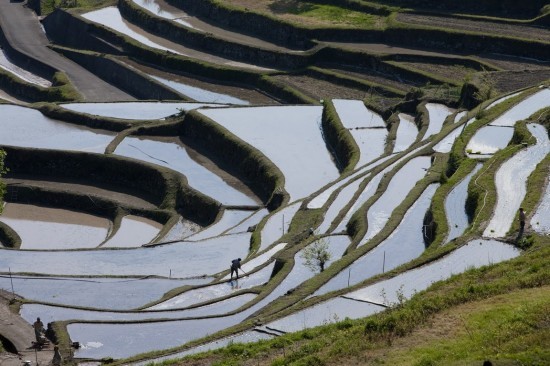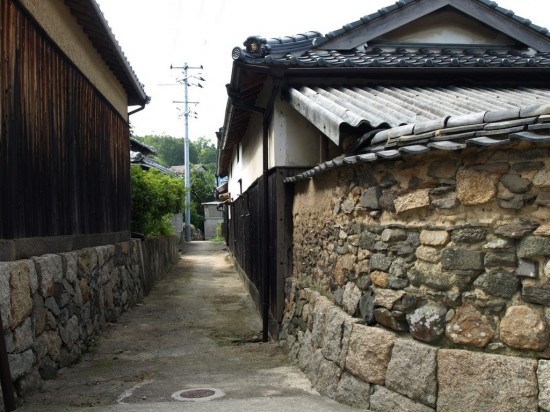Viewing the Setouchi International Art Festival (Part I)

Shodoshima. Photo Osamu Nakamura.
From July to October this year seven islands – Naoshima, Teshima, Shodoshima, Ogijima, Megijima, Oshima, Inujima – at the eastern end of Japan’s Inland Sea played host to the Setouchi International Art Festival (SIAF) under the direction of Fram Kitagawa, whose successful track record includes the Echigo-Tsumari Art Triennial, launched in 2000.
Once the prosperous domain of one of Japan’s industrial behemoths, the island of Naoshima fell into decline in the 1970s. Starting in 1987 Benesse Holdings built accommodation and the Tadao Ando-designed Benesse House and Chichu Art Museum, and launched ongoing projects featuring permanent displays of contemporary art in unconventional locations such as disused houses, earning the island an international reputation as a place of pilgrimage for contemporary art lovers. The idea for SIAF arose just as an increasingly cramped Naoshima was coming under pressure to evolve further as a tourist destination by joining forces with other islands, capitalizing on connecting ferry services.
The island of Teshima, meanwhile, was hit by controversy in the 1990s when it was disclosed as a site for the illegal dumping of industrial waste, while all the islands suffer from accelerating depopulation. The stated object of SIAF is to revive these ailing communities through art.
In this two-part series, critic Noi Sawaragi offers his appraisal of SIAF.
– The Editors

Teshima.
At the beginning of September, I flew into Takamatsu on an early morning flight and by the end of the day had toured Megijima and Ogijima. The next day I checked out the Naoshima Art House Project, which I had previously overlooked, and in the afternoon, Shodoshima. The day after that I spent touring Teshima before heading to Oshima in the evening. On the final day of my trip, with my participation in a symposium at Naoshima’s Benesse House imminent, I had a light lunch before visiting the newly opened Lee Ufan Museum. Due to time constraints I was unable to make it to Inujima, which I had seen previously anyway, but even so, it was a hard schedule given the fierce heat day after day.
The results, however, more than justified the effort. With the exception of Naoshima, which I have visited since its opening (I have fond memories of the Mongolian yurts that once stood on the hillside, and of the communal baths!), it was a completely new experience visiting the various islands. Indeed, were it not for Benesse House, I doubt I would have had any reason to visit Naoshima at all. As with the Echigo-Tsumari Art Triennial, these international art festivals are more about travel than they are about the art experience, and in some cases they offer an experience akin to a pilgrimage. One could say that this is the major difference between these festivals and the so-called “international exhibitions” that have become so popular around the world since the 1990s. At the Yokohama Triennale (2001-), for example, most of the works are “exhibited” in box-like venues that could pass for art museums. The experience could hardly be described as “travel”; rather, it is little more than a somewhat broad interpretation of the normal act of art appreciation. But there are numerous examples among past contemporary art exhibitions that have made use of the vast outdoors and derelict locations. To name just a few, there is the Ushimado International Art Festival (1984-92), which was initially staged in the 1980s in open spaces and along the coast in the town of Ushimado in Okayama prefecture, also facing the Inland Sea, and which may well have been a model for this latest event, as well as the Naguri International Open Air Exhibition (1990-), another event with the flavor of an “art festival of the earth” that has been staged since 1990 in the forested countryside on the shores of Lake Naguri in the Saitama prefecture city of Hanno. However, at these and other similar art festivals/open-air exhibitions, although the chosen locations may undergo a degree of dissimilation at the hands of the artists, things never reach the stage of a qualitative transformation (the kind that would arise if, for example, people visiting the site underwent a complete change). The initiatives undertaken for the Setouchi International Art Festival, on the other hand, involve a process whereby the “Inland Sea” itself, which despite always having been present has remained effectively invisible (in fact, many of those involved in the festival whom I met in Takamatsu had never been to the majority of the islands concerned), is rediscovered along with events of the past, negative legacies, and so on, and serves as a foundation upon which this unfamiliar process itself shapes the art experiences of each individual.
Looking overseas, we can see earlier examples of this approach in Jan Hoet’s “Chambre d’Ami” (1986), in which artists were sent to install works at private homes in 54 locations around the city of Gent, and in Skulptur Projekte Münster (1977-), which uses the entire city of Münster as a stage for art installations and pushes the concept of sculpture to its very limits, although one could probably say that Setouchi, which lasts for a total of four months and involves the linking of seven outlying islands and two harbors by such means as ferries and high-speed boats, is in a different league altogether in terms of its scale.
Naturally, this is not to say I do not have issues with Setouchi. Specifically, there is the concern that the art and artists are little more than opportunities to take a fresh look at the Inland Sea, and the concern that the festival as a travel or tourist experience takes precedence over the primary art experience. Personally I do not see why the art experience must necessarily take precedence over the travel or tourist experience. Essentially, the art experience is charged with the kind of extraordinariness that occurs amid the turmoil of everyday life. In this sense, even the most exceptional of art experiences is clearly rooted in the everyday lives of people. Or to put it another way, an art experience can occur even amid the most mundane of life’s upheavals. This is particularly true of travel and sightseeing, which not only tend to stimulate extraordinariness but are contiguous to people’s lives to begin with. In the same way, art should also be contiguous to people’s lives and travel, for example. Ultimately, the relationship is not such that one subsumes the other.
Given these circumstances, traditional art museums must also change dramatically the roles they play. Limiting the art experience to atemporal single moments and fixing it in eternity may be ideal for homogenous spaces like art museums, but purely visual spaces in the form of such “halls” have already reached their operational limits due to institutional fatigue. One thing I mentioned at the symposium mentioned above (The Shape of the Art Museum of the Future: Yusuke Nakahara, Fram Kitagawa, Katsuhiko Hibino, Akira Tatehata (moderator); September 5, Benesse House Museum) is that the “art museum of the future” should serve less as a systematic focus or stronghold summarizing the art experience and more as a “rest stop” as it were on travels contiguous to life, a role fulfilled at this art festival by the Chichu Art Museum and the Inujima Art Project “Seirensho,” for example. In other words, art museums and art festivals should be thought of not as in conflict with each other but as multiple layers working together in the context of a single experience. Viewed in this light, the sum total of the multiple experiences that mediate between art museums and the outside world each help the other to “breathe,” as it were. This is clearly different from simply “gazing” at an object with one’s eyes or the presentation of an abstract space that is not identifiable with anywhere in the world.
Although it may seem unrelated, you may recall the recent closure of HMV’s flagship store in Shibuya being reported as confirmation of the demise of the age of the CD. And yet, from the outset buying a CD meant nothing more than getting one’s hands on one of those lifeless discs. That being so, as long as the thing people value is communication, it is only natural that CDs will stop selling. At the same time, so-called “summer festivals” in the form of rock festivals rooted in a particular location have become established as part of the music landscape and attract large audiences. Might it be the same thing is actually occurring in the art world? I have heard that attendance at Setouchi surpassed the organizers’ initial target of 300,000 people as early as the beginning of September, which is probably due to the fact that it has a great many “summer festival”-like elements. As well, it is probably correct to conclude that the ability of an arts festival to effectively function on such a scale is due in no small part to the blessings of electronic media such as mobile phones, e-mail and Twitter. Twenty years ago when such media did not exist, it probably would not have been possible to even hold an arts festival linking outlying islands, let alone ensure everything functioned as smoothly as it did on this occasion. Leaving aside the question of whether it is a positive or negative development, as advances continue to be made in electronic media, the development of art not as an object for enlightenment (exhibitions) but as a medium for communication (festivals) looks set to proceed at an even greater pace. (To be continued)
The inaugural Setouchi International Art Festival was on view from July 19 to October 31, 2010, on seven islands in the Seto Inland Sea and in Takamatsu.
